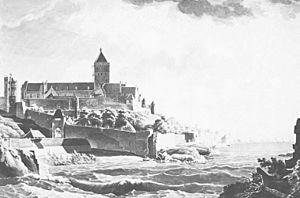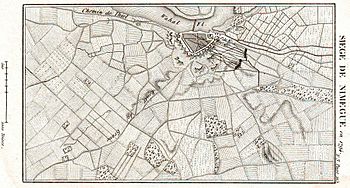Siege of Nijmegen (1794) facts for kids
Quick facts for kids Siege of Nijmegen |
|||||||
|---|---|---|---|---|---|---|---|
| Part of the War of the First Coalition Flanders campaign |
|||||||
 The Valkhof Castle in 1794 shortly before the siege. |
|||||||
|
|||||||
| Belligerents | |||||||
|
|
||||||
| Commanders and leaders | |||||||
| Jean Moreau Herman Daendels Jan Willem de Winter |
William V of Orange Frederick of Orange Duke of York Count of Wallmoden |
||||||
| Strength | |||||||
| 20,000 soldiers (19 October) |
8,000 soldiers (24 October) 50 to 60 cannon (21 October) |
||||||
The Siege of Nijmegen took place from October 27 to November 8, 1794. It was a major battle during the War of the First Coalition. This war involved the new French First Republic (France after its revolution) fighting against a group of European monarchies. These monarchies, including the Dutch Republic, wanted to stop the French Revolution. The siege of Nijmegen was one of the last big fights before the Dutch Republic fell in January 1795. William V, Prince of Orange, who was the leader (called a stadtholder) of the Dutch Republic, made some confusing decisions. This, along with poor teamwork with his allies, helped the French win the battle.
Contents
Why Nijmegen Was Important
In 1787, the Dutch leader, William V, Prince of Orange, had to leave his home in The Hague. He went to the city of Nijmegen for safety. This happened because a group called the Patriots, who wanted more power for the people, were against him. Later, the Prussian army helped William V regain control, and the Patriots had to flee.
By the summer of 1794, the French Revolutionary army was winning many battles. They were pushing back the armies of the First Coalition. This group included soldiers from Britain, Hanover, Hesse, and the Dutch Republic. These armies had to retreat north to defend the Dutch Republic.
The Battle Begins
A citizen of Nijmegen, Jan van Hulst, wrote about the siege in his diary.
French Army Approaches
On October 3, Dutch soldiers built a floating bridge across the Waal River near Nijmegen. This helped troops move around easily. Soldiers from different countries came and went from the city. The French army was getting closer every day. Small battles happened near the city's outposts (outer defenses). The city and its forts were made stronger.
The French army, called the Armée du Nord, was led by General Jean-Charles Pichegru. They were helped by the Batavian Legion, which was made up of Dutch Patriots. These French and Patriot forces captured the city of 's-Hertogenbosch on October 12 after a three-week siege.
General Pichegru then got sick and went to recover. General Jean Victor Marie Moreau took over. On October 18 or 19, French troops crossed the Maas River. There were battles in nearby towns like Puiflijk and Appeltern. The French army, with about 20,000 soldiers, fought against British and Emigrant (French people who left France) soldiers. The British lost many men, and most of the Emigrant soldiers were killed or captured. Soon, the entire area called the Land van Maas en Waal was controlled by the French.
On October 20, there were more small fights. The French also started attacking Tiel and cut off the connection between Grave and Nijmegen. Grave was surrounded but not attacked directly because the French wanted to take Nijmegen first. Grave was a very strong fortress city.
Skirmishes and Decisions
On October 21, a Hanoverian general named Wallmoden asked if Nijmegen had enough food for a siege. He thought the city should be evacuated (emptied). The French had reached Neerbosch, and the British had left their outer defenses.
At first, the stadtholder, William V, ordered that Nijmegen should not be defended. So, people started leaving the city. On October 22, there was heavy fighting, and many Allied soldiers were hurt. The French came very close to the city but then pulled back.
On October 24 and 25, the city was put on high alert. Food started to run low, and soldiers began taking food from people in the countryside. The floating bridge across the Waal River was prepared to be burned so the French could not use it. The French tried to destroy the bridge with cannons, but they failed.
The Siege Begins
On October 27, the cannons on Nijmegen's walls fired for the first time. The French fired back right away. The French set up their cannons in a nearby village called Ooij. The Allies tried to stop them, but it was difficult.
On October 28, Prince William V changed his mind. He said he loved Nijmegen too much to give it up. But many people, including General Wallmoden, thought defending the city was a bad idea because there wasn't enough food. General Wallmoden even left the city. The French cannons were very effective, hitting the eastern walls of Nijmegen.
From October 29 to November 1, the French did not attack. Instead, they carefully built more trenches and cannon positions. The defenders fired at them, but it didn't do much. There was a serious shortage of wood in Nijmegen, and people burned anything they could to stay warm.
On November 2, the Allied forces fired many cannons at the French. The French did not fire back. That night, about 3,000 soldiers and their wagons left the city. Hanoverian troops tried to attack the French trenches but only managed to steal some shovels, losing many men.
The next day, more people and supplies were evacuated. Bombs and cannonballs were thrown into the river so the French couldn't use them. A lot of flour was also dumped, but hungry citizens pulled it out of the water.
Then, the three Princes of Orange arrived in Nijmegen. They decided to stop the evacuation and continue the siege. About 3,600 new British and Dutch soldiers arrived to help defend the city.
On November 4, the cannons on the walls were made stronger. The British launched a large attack on the French trenches. They managed to take the first two lines of trenches. But at the third line, the French fought back hard with cannons and muskets. The British suffered heavy losses and had to retreat. Many Scottish soldiers were shot by French Jäger (light infantry) while trying to climb a hill.
November 5 was quieter. More Allied troops and cannons were brought into Nijmegen. The British commander, the Duke of York, planned a counter-attack. But it was canceled when the Hanoverian soldiers refused to join. The British troops then started to leave the city.
French Bombardment and Fall
On November 6, the stadtholder again promised the people he would defend the city. He even said reinforcements would arrive in three days. That afternoon, the French finished their preparations. Around 7 or 8 pm, they started a heavy bombardment with howitzers. This caused great panic in the city. Most people hid in their cellars.
Dutch troops tried desperate attacks, but they lost more soldiers than they could hurt the French. The floating bridge was damaged but quickly repaired. That night, many British and Hanoverian soldiers left the city. Some British soldiers started looting houses, taking goods to the other side of the river. Dutch soldiers and armed citizens arrested many of them, and about 50 looters were executed.
On November 7, more troops left Nijmegen. The French howitzer bombardment continued fiercely. Fires broke out in the city, including one at the Dominicus Church. The fire spread to nearby houses. The City Council met, but most of its members had already fled.
After midnight, the remaining British, Hanoverian, and Hessian troops began to leave. The French fired heavily on the pontoon bridge as the Allies crossed it. As soon as the British crossed, they set the bridge on fire. This stopped the remaining Dutch soldiers from escaping.
Seeing the burning bridge, the French realized the city was almost empty. They sent soldiers to check the walls. They climbed over the walls and entered the city without resistance. They opened three gates, letting the main French army in. Around 4 am, French troops spread out to take control of important points. A Dutch Patriot captain, Reine, demanded access to a gate in the name of the French Republic, and it was granted.
The Dutch soldiers who couldn't escape because of the burning bridge were taken prisoner. They were disarmed but treated with respect. The surrender of Nijmegen was signed, and the city fell to the French on November 8.
Jan van Hulst wrote that the French soldiers were very disciplined. They did not loot and walked through the streets happily, singing and greeting citizens. The British troops still held a fort across the Waal River and fired on the city for a while, but it didn't do much damage.
What Happened Next
With Nijmegen captured, the French First Republic had reached the Rhine and Waal rivers. These rivers were often seen as France's "natural boundary." However, the Dutch Patriots wanted the French to help free the rest of the Dutch Republic.
On January 10, 1795, the French army crossed the frozen Waal River. After this, there was little fighting needed. On January 16, the province of Utrecht surrendered. On the night of January 18-19, a peaceful revolution happened in Amsterdam. The Batavian Republic was created, and many supporters of William V, including the stadtholder himself, fled to England. Similar revolutions happened in other Dutch cities.
In the spring of 1795, the French government and the new Batavian government talked about which areas France would take. They agreed that only certain areas (like Staats-Vlaanderen) would become French territory. Nijmegen became part of the new Batavian Republic.



